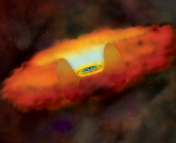In this series of posts, we sit down with a few of the keynote speakers of the 231st AAS meeting to learn more about them and their research. You can see a full schedule of their talks here!
By measuring the brightness of dying white dwarf stars and pulsating Cepheid variables, Adam Riess accurately determines the distance to galaxies far, far away to uncover the biggest secrets of the (local) universe.

As a professor, Riess divides his time between John Hopkins University and the Space Telescope Science Institute (STScI). His plenary talk “A New Measurement of the Expansion Rate of the Universe, Evidence of New Physics?” tackles a major source of tension in the field of cosmology — the Hubble constant.
Armed with a Physics major from MIT, Riess’s path into research was swayed by his “interest and excitement [for the] questions about the universe as a whole.” At the time, questions like “how old is the universe? what’s [the universe] made of?” was the sort of conversational topics Riess expected to only really encounter with a philosopher. “Once I realised that was a field called observational cosmology, I was pretty certain that’s what I wanted to do.”
As a professional astronomer, Riess was lucky enough to be at the STScI during several servicing missions for the Hubble Space Telescope (HST) and was able to speak to the astronauts about the work new instrumentation would enable. Riess describes this experience as exciting because “when you use a new camera on Hubble, you’re in many cases, taking the deepest images ever taken. Surpassing that year after year.”
Shortly after grad school (Harvard), Riess led a study as part of the High-Z Supernova Search Team which used measurements of distant type-Ia supernova (exploding white dwarfs) to determine the universe is expanding faster today than it did in the past — it’s accelerating, a discovery which landed Riess a share of the Nobel Prize in Physics back in 2011. Riess likes to joke that “since we were awarded the Nobel Prize, it must be right”, but that doesn’t mean work has stopped. His team, known as the Supernova H0 for Equation of State (SHOES) team, recently improved the uncertainty in measurements of the local Hubble constant from 3.3 to 2.4%. With the help of GAIA and the HST, Riess hopes to reduce uncertainty in future measurements to 1% — an “audacious” but not unreasonable goal in the next 5 years.
Nobel-winning Riess has two tips for students hoping to pursue a career in research, starting with “learn to code in something.” Being able to code is a requirement for most, if not all, productive research in astrophysics as “nobody has done exactly that thing before so you can’t just used canned software or some other product”. Moreover, Riess emphasises how learning to code is a highly employable skill which transfers well to jobs outside of research. Aside from that, Riess recommends picking “one thing” and “trying to become really knowledgeable”. Achieving the status of “go-to person for questions/studies of that particular step, tool or calculation” will go far when trying to become established in the big collaborations which are common practice in modern astronomy.
To mark the 20th anniversary of our accelerating universe, Riess will celebrate by exploring the recently-discovered tension between the local Hubble constant and the value which is calculated from observations of the Cosmic Microwave Background (CMB). Over time, uncertainties in measurements have decreased and the two different methods for calculating this constant have diverged towards slightly different values. Today* this tension level sits at 3.4 sigma, a difference which is statistically significant and therefore cannot be ignored. According to Riess “this is a very exciting moment because if it’s not wrong, it might indicate that something else is going on.”
Don’t miss Riess’s talk on Tuesday 9th January, 11:40 am at #AAS231!
* A wonderful colleague just pointed out Riess’s latest publication on arxiv, so actually the tension is now at 3.7 sigma – can’t believe my interview is already out of date.



